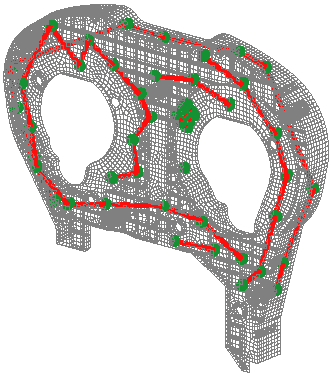The objective of the SDT in this area is to provide flexible access to all standard and many advanced tools to correlate experimental modal analysis results with industrial size finite element models.
Topology correlation
SDT visualization and analysis tools support general sensor setups with mixed translation/rotation measurements, non orthogonal sensors, laser measurements, non-coincident test and FEM nodes,… fe_sens provides sensor placement algorithms and automated and/or directed test/FEM node linking with support of different test/FEM coordinate systems, mixed translation/rotation sensors,and rotation interpolation for non- coincident nodes of volume models. The use of observability equations gives access to all correlation and shape expansion methods with no need to modify the FEM model (a unique and very time saving feature).
 |
Automated test to FEM node linking |
Shape expansion
Expansion methods for arbitrary sensor configurations are modal, static, dynamic, and the advanced minimum residual with and without measurement error. The use of FEM model reduction lifts the computational restriction on using advanced methods.

Reduced basis dynamic expansion for a superelement model of Ariane 5 imported from PERMAS. (EADS-ST)
Correlation criteria
The new ii_mac GUI supports the COMAC, MAC, MACCO, POC, and relative error criteria,with standard graphical and tabular output, automated mode pairing, computation and use of reduced mass in all the criteria. Functionality is accessed either though menus or through the SDT handle object associated with the figure.
MAC, MAC-M and MAC/frequency plots generated.
